Displacement Monitoring in Airport Runways by Persistent Scatterers SAR Interferometry
Abstract
1. Introduction
2. Aim and Objectives
- to assess runway displacements at the millimetre scale and evaluate their trend on a multi-year scale using the PSI monitoring technique;
- to compare the results obtained with the PSI technique and the traditional topographic levelling method.
3. Runway Monitoring Techniques
3.1. Established Techniques
3.1.1. Topographic Levelling
3.1.2. LiDAR Surveys
3.2. Persistent Scatterers Interferometry (PSI)
4. Case Study
4.1. Site Description
4.2. Levelling Data
4.3. SAR Imagery
4.4. Data Processing
- Generation of differential interferograms out of the stack of SAR images;
- Implementation of High definition Digital Elevation Models (DEM) for topographic phase-term removal;
- Selection of candidate PS points, through the calculation of the Amplitude Dispersion Index;
- Coherence-based filtering of the dataset;
- Phase unwrapping;
- Identification and removal of the phase values not related to the displacements: evaluation of spatial, orbital, and atmospheric decorrelations;
- Identification of the displacements and calculation of deformation time series.
- All the PSs in the vicinity of the observed levelled point are selected within a distance radius of 10 m (Figure 3a,b);
- Out of all the selected PSs, a single displacement time series is derived by calculating the moving average of the deformations at each acquisition date (Figure 3c);
- The displacement velocity is defined by a linear regression of the displacement against time (Figure 3c).
5. Results
6. Conclusions
Author Contributions
Funding
Acknowledgments
Conflicts of Interest
References
- Federal Aviation Administration (FAA). Advisory Circular AC 150/5370-10H—Standard Specifications for Construction of Airports. 2018. Available online: https://www.faa.gov/documentLibrary/media/Advisory_Circular/150-5370-10H.pdf (accessed on 10 March 2020).
- Federal Aviation Administration (FAA). Advisory Circular AC 150/5320-6F—Airport Pavement Design and Evaluation. 2016. Available online: https://www.faa.gov/documentLibrary/media/Advisory_Circular/150-5320-6F.pdf (accessed on 10 March 2020).
- Li, D.; Selig, E.T. Cumulative Plastic Deformation for Fine-Grained Subgrade Soils. J. Geotech. Eng. 1996, 122, 1006–1013. [Google Scholar] [CrossRef]
- Zhou, J.; Gong, X.; Li, J. Experimental study on saturated soft clay under cyclic loading. Ind. Constr. 2000, 30, 43–47. [Google Scholar]
- Bevilacqua, M.; Braglia, M. The analytic hierarchy process applied to maintenance strategy selection. Reliab. Eng. Syst. Saf. 2000, 70, 71–83. [Google Scholar] [CrossRef]
- Cosser, E.; Roberts, G.W.; Meng, X.; Dodson, A.H. Measuring the Dynamic Deformation of Bridges Using a Total Station. In Proceedings of the 11th FIG Symposium on Deformation Measurements, Santorini, Greece, 25–28 May 2003. [Google Scholar]
- Chen, W.; Yuan, J.; Li, M. Application of GIS/GPS in Shanghai Airport Pavement Management System. Procedia Eng. 2012, 29, 2322–2326. [Google Scholar] [CrossRef]
- Barbarella, M.; De Blasiis, M.R.; Fiani, M. Terrestrial laser scanner for the analysis of airport pavement geometry. Int. J. Pavement Eng. 2017, 20, 466–480. [Google Scholar] [CrossRef]
- Ciampoli, L.B.; Gagliardi, V.; Clementini, C.; Latini, D.; Del Frate, F.; Benedetto, A. Transport Infrastructure Monitoring by InSAR and GPR Data Fusion. Surv. Geophys. 2019, 41, 371–394. [Google Scholar] [CrossRef]
- Bru, G.; Herrera, G.; Tomás, R.; Duro, J.; De La Vega, R.; Mulas, J. Control of deformation of buildings affected by subsidence using persistent scatterer interferometry. Struct. Infrastruct. Eng. 2010, 9, 1–13. [Google Scholar] [CrossRef]
- Koudogbo, F.; Urdiroz, A.; Robles, J.G.; Chapron, G.; Lebon, G.; Fluteaux, V.; Priol, G. Radar interferometry as an innovative solution for monitoring the construction of the Grand Paris Express metro network—First results. In Proceedings of the World Tunnel Conference, Dubai, UAE, 21–25 April 2018. [Google Scholar]
- Ferretti, A.; Prati, C.; Rocca, F. Nonlinear subsidence rate estimation using permanent scatterers in indifferential SAR interferometry. IEEE Trans. Geosci. Remote Sens. 2000, 38, 2202–2212. [Google Scholar] [CrossRef]
- Ferretti, A.; Prati, C.; Rocca, F. Analysis of permanent scatterers in {SAR} interferometry. IEEE Trans. Geosci. Remote Sens. 2000, 39, 761–763. [Google Scholar]
- Elhassan, I.M.; Ali, A. Comparative study of accuracy in distance measurement using: Optical and digital levels. J. King Saud Univ. Eng. Sci. 2011, 23, 15–19. [Google Scholar] [CrossRef]
- Kuhlmann, H.; Glaser, A. Investigation of New Measurement Techniques for Bridge Monitoring. In Proceedings of the 2nd Symposium on Geodesy for Geotechnical and Structural Engineering, Berlin, Germany, 21–24 May 2002. [Google Scholar]
- Uddin, W.; Gutelius, B.; Parrish, C. Airborne Laser Survey Specifications and Quality Management Protocols for Airport Obstruction Surveys. Transp. Res. Rec. J. Transp. Res. Board 2011, 2214, 117–125. [Google Scholar] [CrossRef]
- Hill, C.D.; Sippel, K.D. Modern Deformation Monitoring: A Multi Sensor Approach. In Proceedings of the FIG XXII International Congress, Washington, DC, USA, 19–26 April 2002. [Google Scholar]
- Radovanovic, R.S.; Teskey, W.F. Dynamic Monitoring of Deforming Structures: GPS verses Robotic Tacheometry Systems. In Proceedings of the 10th FIG International Symposium on Deformation Measurements, Orange, CA, USA, 19–22 March 2001. [Google Scholar]
- Meng, X. Real-time Deformation Monitoring of Bridges Using GPS/Accelerometers. Ph.D. Thesis, University of Nottingham, Nottingham, UK, 2002. [Google Scholar]
- Uddin, W.; Al-Turk, E. Airport obstruction space management using airborne LIDAR three dimensional digital terrain mapping. In Proceedings of the Federal Aviation Administration Technology Transfer Conference, Washington, DC, USA, 20–22 April 2002. [Google Scholar]
- Kim, J.S.; Lee, J.C.; Kang, I.J.; Cha, S.Y.; Choi, H.; Lee, T.G. Extraction of geometric information on highway using terrestrial laser scanning technology. Int. Arch. Photogramm. Remote Sens. Spat. Inf. Sci. 2008, 37, 539–544. [Google Scholar]
- Williams, K.; Olsen, M.J.; Roe, G.V.; Glennie, C. Synthesis of Transportation Applications of Mobile LIDAR. Remote Sens. 2013, 5, 4652–4692. [Google Scholar] [CrossRef]
- Laurent, J.; Hébert, J.F.; Lefebvre, D.; Savard, Y. Using 3D Laser Profiling Sensors for the Automated Measurement of Road Surface Conditions. In Proceedings of the 7th RILEM International Conference on Cracking in Pavements, Delft, The Netherlands, 20–22 June 2012; Volume 4, pp. 157–167. [Google Scholar]
- Pu, S.; Rutzinger, M.; Vosselman, G.; Elberink, S.O. Recognizing basic structures from mobile laser scanning data for road inventory studies. ISPRS J. Photogramm. Remote Sens. 2011, 66, S28–S39. [Google Scholar] [CrossRef]
- De Blasiis, M.R.; Di Benedetto, A.; Fiani, M. Mobile Laser Scanning Data for the Evaluation of Pavement Surface Distress. Remote Sens. 2020, 12, 942. [Google Scholar] [CrossRef]
- Barbarella, M.; D’Amico, F.; De Blasiis, M.R.; Di Benedetto, A.; Fiani, M. Use of Terrestrial Laser Scanner for Rigid Airport Pavement Management. Sensors 2017, 18, 44. [Google Scholar] [CrossRef] [PubMed]
- Colesanti, C.; Ferretti, A.; Prati, C.; Rocca, F. Monitoring landslides and tectonic motions with the Permanent Scatterers Technique. Eng. Geol. 2003, 68, 3–14. [Google Scholar] [CrossRef]
- Colombo, D.; Farina, P.; Moretti, S.; Nico, G.; Prati, C. Land subsidence in the Firenze-Prato-Pistoia basin measured by means of spaceborne SAR interferometry. In Proceedings of the 2003 IEEE International Geoscience and Remote Sensing Symposium (IGARSS 2003), Toulouse, France, 21–25 July 2003; Volume 4, pp. 2927–2929. [Google Scholar]
- Frattini, P.; Crosta, G.B.; Allievi, J. Damage to Buildings in Large Slope Rock Instabilities Monitored with the PSInSAR™ Technique. Remote Sens. 2013, 5, 4753–4773. [Google Scholar] [CrossRef]
- Yu, B.; Liu, G.; Zhang, R.; Jia, H.; Li, T.; Wang, X.; Dai, K.; Ma, D. Monitoring subsidence rates along road network by persistent scatterer SAR interferometry with high-resolution TerraSAR-X imagery. J. Mod. Transp. 2013, 21, 236–246. [Google Scholar] [CrossRef]
- Perissin, D.; Wang, Z.; Lin, H. Shanghai subway tunnels and highways monitoring through Cosmo-SkyMed Persistent Scatterers. ISPRS J. Photogramm. Remote Sens. 2012, 73, 58–67. [Google Scholar] [CrossRef]
- Fárová, K.; Jelének, J.; Kopačková-Strnadová, V.; Kycl, P. Comparing DInSAR and PSI Techniques Employed to Sentinel-1 Data to Monitor Highway Stability: A Case Study of a Massive Dobkovičky Landslide, Czech Republic. Remote Sens. 2019, 11, 2670. [Google Scholar] [CrossRef]
- Milillo, P.; Giardina, G.; Perissin, D.; Milillo, G.; Coletta, A.; Terranova, C. Pre-Collapse Space Geodetic Observations of Critical Infrastructure: The Morandi Bridge, Genoa, Italy. Remote Sens. 2019, 11, 1403. [Google Scholar] [CrossRef]
- D’Amico, F.; Gagliardi, V.; Ciampoli, L.B.; Tosti, F. Integration of InSAR and GPR techniques for monitoring transition areas in railway bridges. NDT E Int. 2020, 115, 102291. [Google Scholar] [CrossRef]
- Alani, A.M.; Tosti, F.; Bianchini Ciampoli, L.; Gagliardi, V.; Benedetto, A. Integration of GPR and InSAR methods for the health monitoring of masonry arch bridges. NDT E Int. 2020, in press. [Google Scholar] [CrossRef]
- Jung, J.; Kim, D.-J.; Vadivel, S.K.P.; Yun, S.-H. Long-Term Deflection Monitoring for Bridges Using X and C-Band Time-Series SAR Interferometry. Remote Sens. 2019, 11, 1258. [Google Scholar] [CrossRef]
- Ciampoli, L.B.; Gagliardi, V.; Calvi, A.; D’Amico, F.; Tosti, F. Automatic network level bridge monitoring by integration of InSAR and GIS catalogues. Multimodal Sens. Technol. Appl. 2019, 11059, 110590I. [Google Scholar] [CrossRef][Green Version]
- Roccheggiani, M.; Piacentini, D.; Tirincanti, E.; Perissin, D.; Menichetti, M. Detection and Monitoring of Tunneling Induced Ground Movements Using Sentinel-1 SAR Interferometry. Remote Sens. 2019, 11, 639. [Google Scholar] [CrossRef]
- Barla, G.; Tamburini, A.; Del Conte, S.; Giannico, C. InSAR monitoring of tunnel induced ground movements. Géoméch. Tunnelbau 2016, 9, 15–22. [Google Scholar] [CrossRef]
- Yang, Z.; Schmid, F.; Roberts, C. Assessment of Railway Performance by Monitoring Land Subsidence. In Proceedings of the 6th IET Conference on Railway Condition Monitoring (RCM 2014), Birmingham, UK, 17–18 September 2014; pp. 1–6. [Google Scholar]
- Chang, L.; Dollevoet, R.P.B.J.; Hanssen, R.F. Nationwide Railway Monitoring Using Satellite SAR Interferometry. IEEE J. Sel. Top. Appl. Earth Obs. Remote Sens. 2016, 10, 596–604. [Google Scholar] [CrossRef]
- Qin, X.; Liao, M.; Zhang, L.; Yang, M. Structural Health and Stability Assessment of High-Speed Railways via Thermal Dilation Mapping With Time-Series InSAR Analysis. IEEE J. Sel. Top. Appl. Earth Obs. Remote Sens. 2017, 10, 2999–3010. [Google Scholar] [CrossRef]
- Tosti, F.; Gagliardi, V.; D’Amico, F.; Alani, A.M. Transport infrastructure monitoring by data fusion of GPR and SAR imagery information. Transp. Res. Procedia 2020, 45, 771–778. [Google Scholar] [CrossRef]
- Jiang, L.; Lin, H. Integrated analysis of SAR interferometric and geological data for investigating long-term reclamation settlement of Chek Lap Kok Airport, Hong Kong. Eng. Geol. 2010, 110, 77–92. [Google Scholar] [CrossRef]
- Gao, M.; Gong, H.; Chen, B.; Zhou, C.; Chen, W.; Liang, Y.; Shi, M.; Si, Y. InSAR time-series investigation of long-term ground displacement at Beijing Capital International Airport, China. Tectonophysics 2016, 691, 271–281. [Google Scholar] [CrossRef]
- Jiang, Y.; Liao, M.; Wang, H.; Zhang, L.; Balz, T. Deformation Monitoring and Analysis of the Geological Environment of Pudong International Airport with Persistent Scatterer SAR Interferometry. Remote Sens. 2016, 8, 1021. [Google Scholar] [CrossRef]
- Sarmap. SARscape Technical Description. Available online: http://www.sarmap.ch/pdf/SARscapeTechnical.pdf/ (accessed on 22 July 2020).
- Sarmap. SAR-Guidebook. Available online: http://www.sarmap.ch/pdf/SAR-Guidebook.pdf (accessed on 22 July 2020).
- NASA. The Shuttle Radar Topography Mission (SRTM) Collection User Guide. 2015. Available online: https://lpdaac.usgs.gov/documents/179/SRTM_User_Guide_V3.pdf (accessed on 11 February 2020).
- Rodriguez, E.; Morris, C.S.; Belz, J.E.; Chapin, E.C.; Martin, J.M.; Daffer, W.; Hensley, S. An assessment of the SRTM Topographic Products; Technical Report JPL D-31639; Jet Propulsion Laboratory: Pasadena, CA, USA, 2005; p. 143. [Google Scholar]
- Giraldo, R.; Delicado, P.; Mateu, J. Ordinary kriging for function-valued spatial data. Environ. Ecol. Stat. 2010, 18, 411–426. [Google Scholar] [CrossRef]
- Papritz, A.; Stein, A. Spatial prediction by linear kriging. In Spatial Statistics for Remote Sensing; Springer Science and Business Media LLC: Berlin/Heidelberg, Germany, 1999; Volume 1, pp. 83–113. [Google Scholar]
- Doin, M.-P.; Lasserre, C.; Peltzer, G.; Cavalié, O.; Doubre, C. Corrections of stratified tropospheric delays in SAR interferometry: Validation with global atmospheric models. J. Appl. Geophys. 2009, 69, 35–50. [Google Scholar] [CrossRef]
- Fattahi, H.; Amelung, F. InSAR bias and uncertainty due to the systematic and stochastic tropospheric delay. J. Geophys. Res. Solid Earth 2015, 120, 8758–8773. [Google Scholar] [CrossRef]

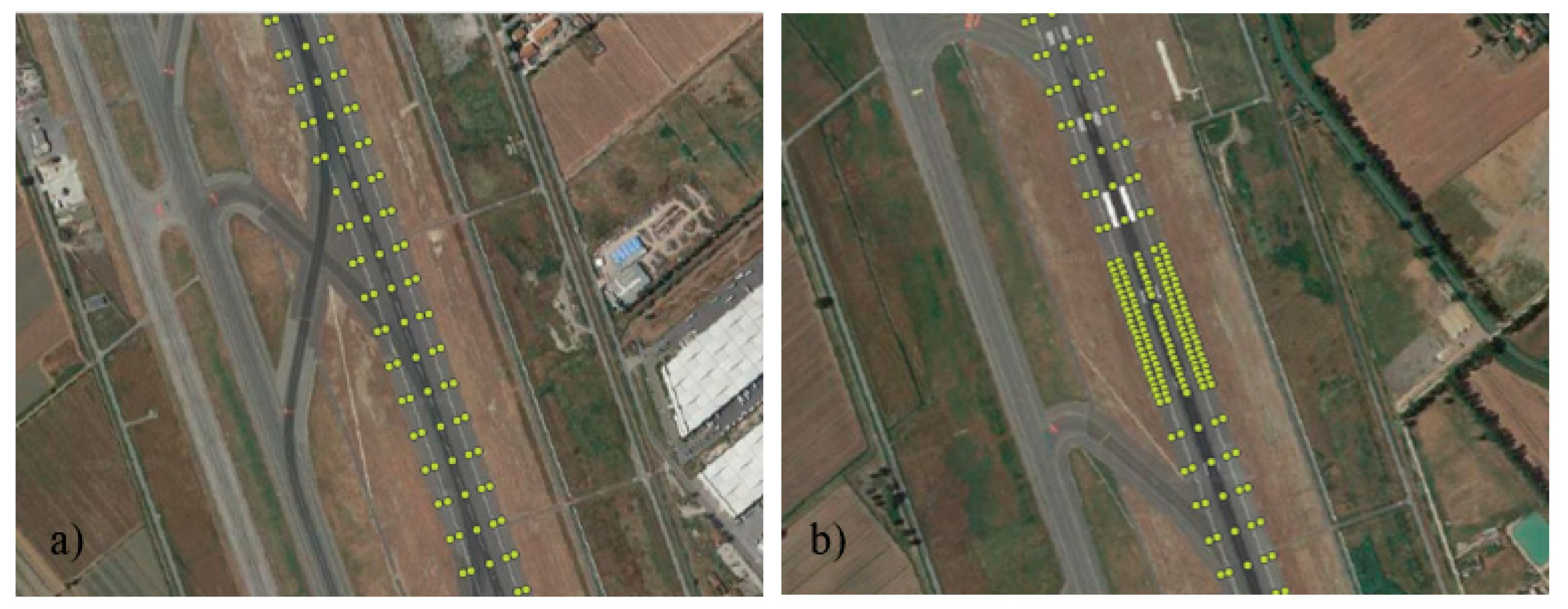
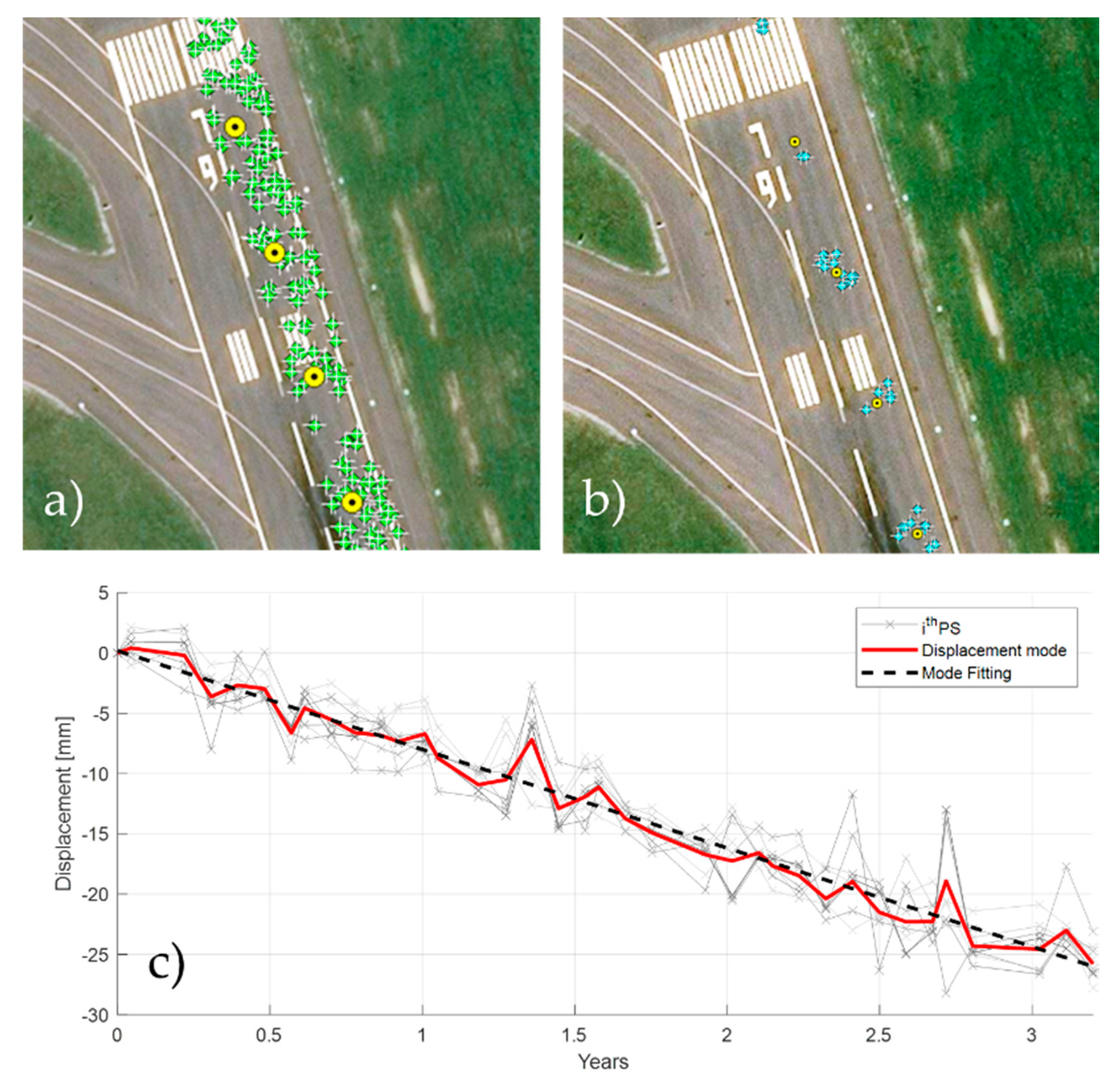
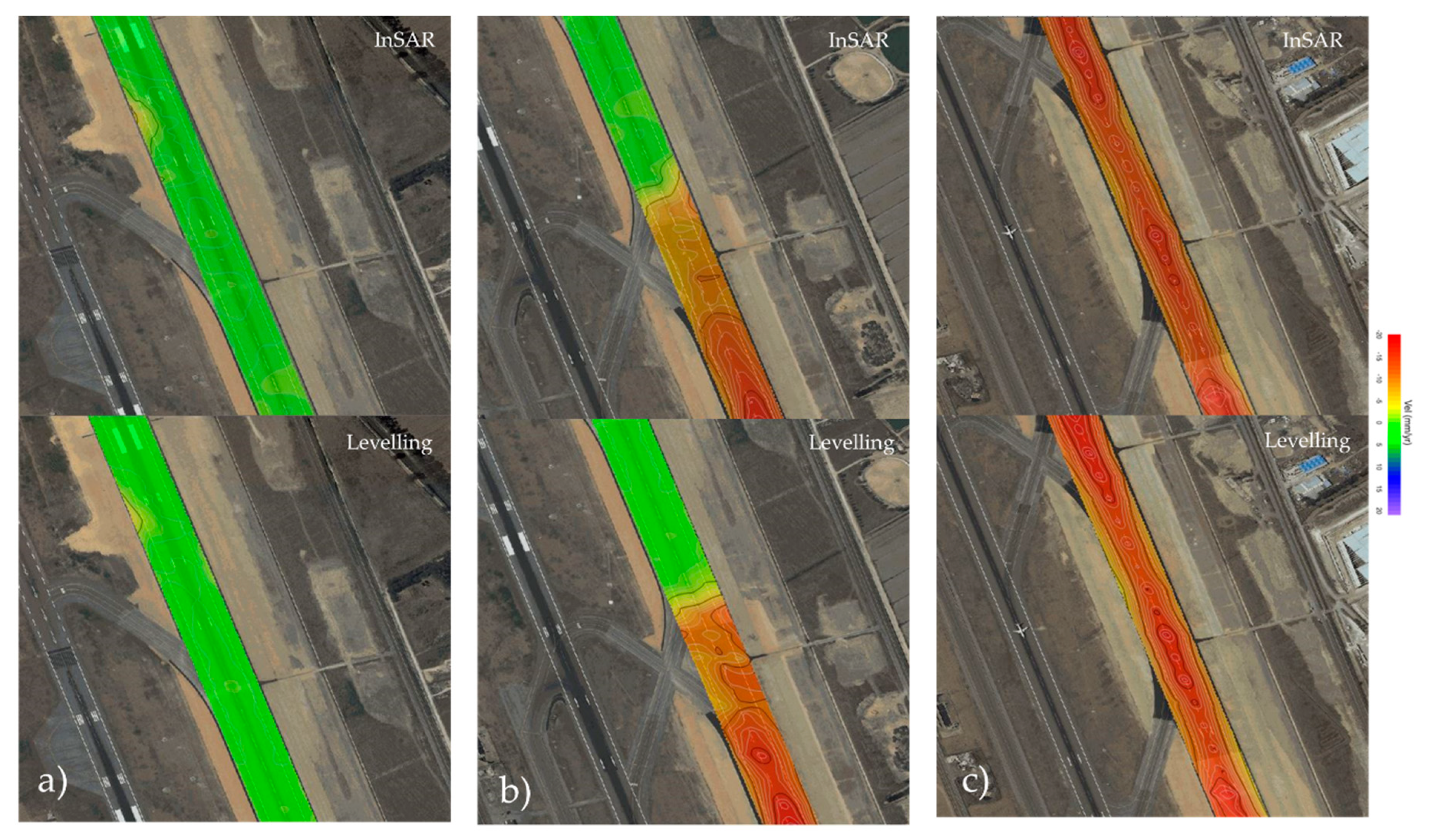
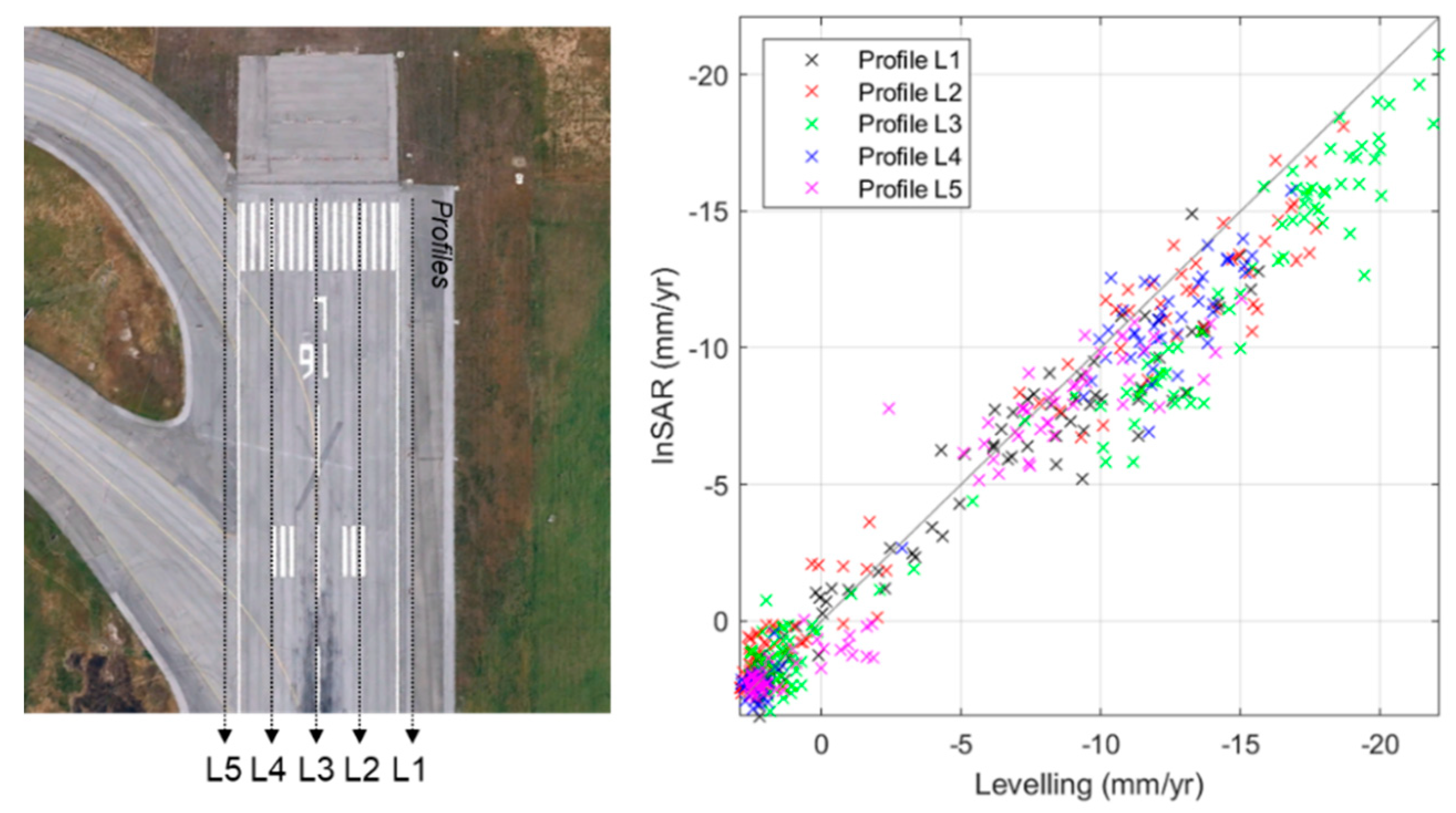
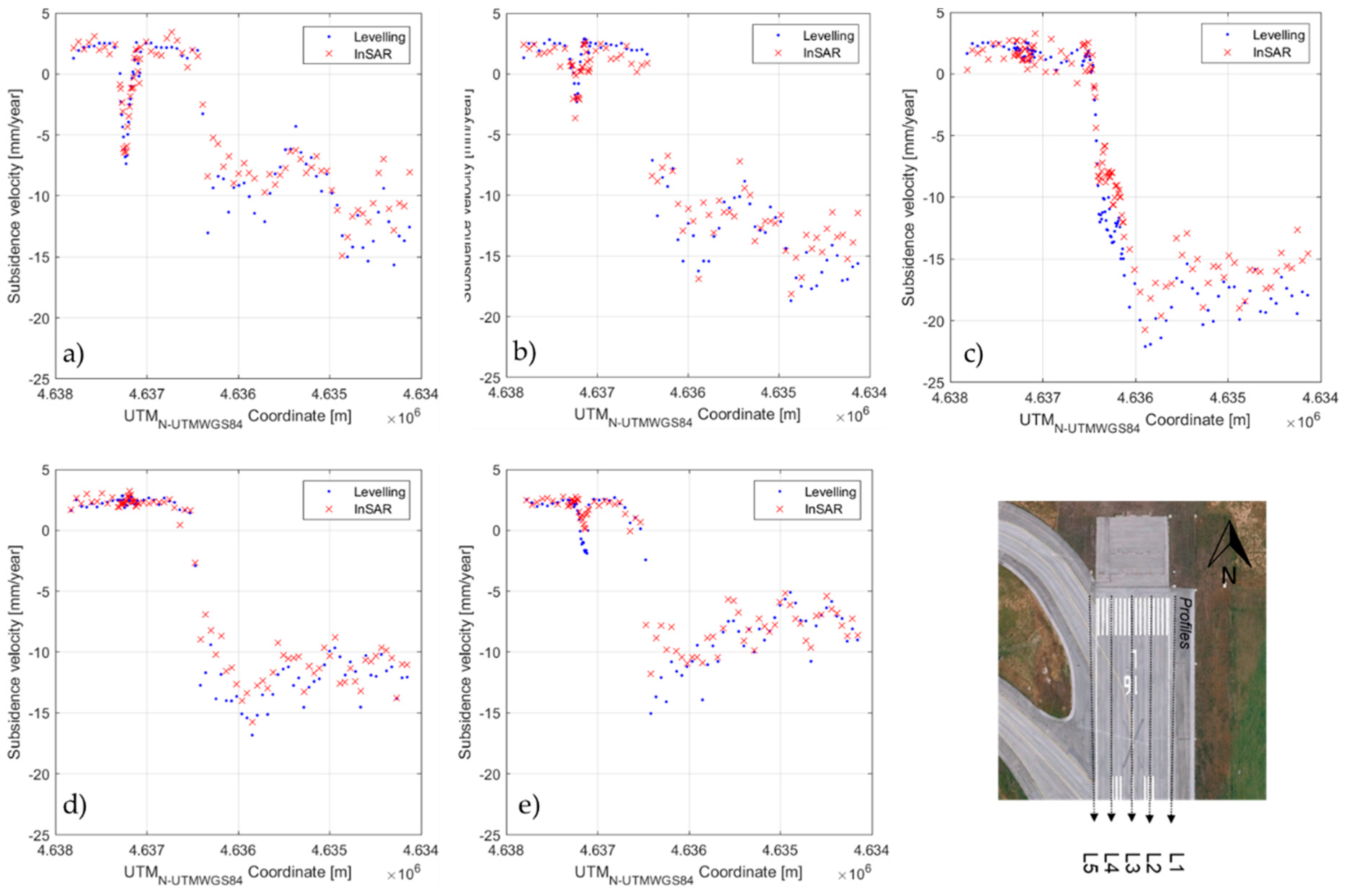
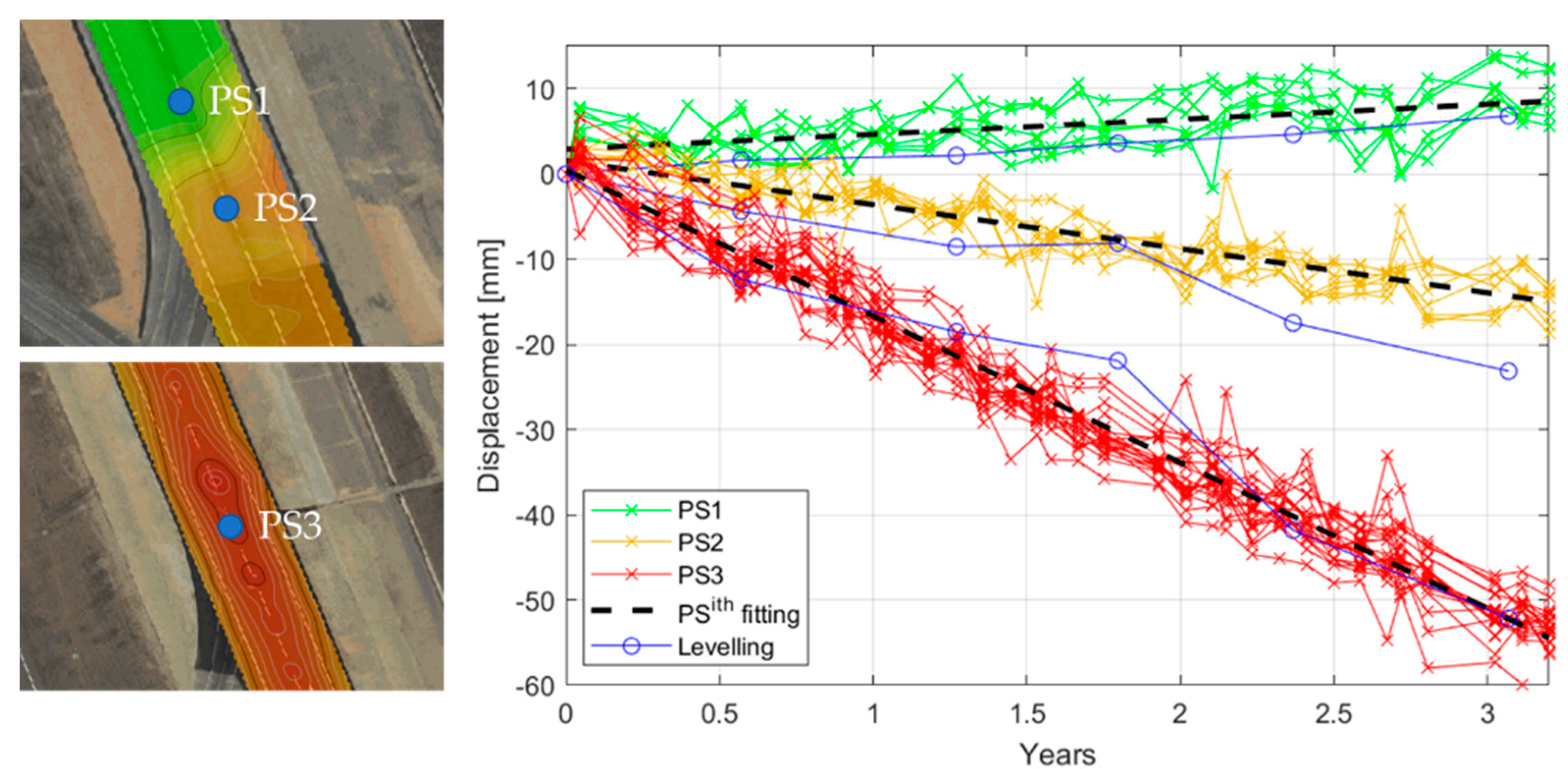
| Leica DNA03 | |
|---|---|
| Measuring Range | Up to 110 m |
| Measuring Time | Operator Dependent |
| Levelling Accuracy (Std Dev.) | ±0.3 mm/km |
| Compensator | Pendulum with magnetic damping |
| Display | LCD |
| Ascending Geometry | Descending Geometry | |
|---|---|---|
| Number of Images | 35 | 37 |
| Reference Period | 01/2015–04/2019 | 03/2016–04/2019 |
| Frequency/Wavelength | 9.6 GHz/3.1 cm | |
| Ground-Range Resolution | 3 m | |
| Azimuth Resolution | 3 m | |
| Survey Profile | r (-) | RSME (mm/yr) |
|---|---|---|
| L1 | 0.9731 | 1.6430 |
| L2 | 0.9837 | 1.6931 |
| L3 | 0.9857 | 2.3477 |
| L4 | 0.9907 | 1.3247 |
| L5 | 0.9681 | 1.5361 |
| Surveyed Point | Displacement Velocity by Levelling (mm/yr) | Displacement Velocity by InSAR (mm/yr) | RSME (mm) |
|---|---|---|---|
| PS1 | 1.68 | 1.76 | 2.4659 |
| PS2 | −6.21 | −5.16 | 4.9875 |
| PS3 | −16.93 | −17.16 | 3.9101 |
Publisher’s Note: MDPI stays neutral with regard to jurisdictional claims in published maps and institutional affiliations. |
© 2020 by the authors. Licensee MDPI, Basel, Switzerland. This article is an open access article distributed under the terms and conditions of the Creative Commons Attribution (CC BY) license (http://creativecommons.org/licenses/by/4.0/).
Share and Cite
Bianchini Ciampoli, L.; Gagliardi, V.; Ferrante, C.; Calvi, A.; D’Amico, F.; Tosti, F. Displacement Monitoring in Airport Runways by Persistent Scatterers SAR Interferometry. Remote Sens. 2020, 12, 3564. https://doi.org/10.3390/rs12213564
Bianchini Ciampoli L, Gagliardi V, Ferrante C, Calvi A, D’Amico F, Tosti F. Displacement Monitoring in Airport Runways by Persistent Scatterers SAR Interferometry. Remote Sensing. 2020; 12(21):3564. https://doi.org/10.3390/rs12213564
Chicago/Turabian StyleBianchini Ciampoli, Luca, Valerio Gagliardi, Chiara Ferrante, Alessandro Calvi, Fabrizio D’Amico, and Fabio Tosti. 2020. "Displacement Monitoring in Airport Runways by Persistent Scatterers SAR Interferometry" Remote Sensing 12, no. 21: 3564. https://doi.org/10.3390/rs12213564
APA StyleBianchini Ciampoli, L., Gagliardi, V., Ferrante, C., Calvi, A., D’Amico, F., & Tosti, F. (2020). Displacement Monitoring in Airport Runways by Persistent Scatterers SAR Interferometry. Remote Sensing, 12(21), 3564. https://doi.org/10.3390/rs12213564











